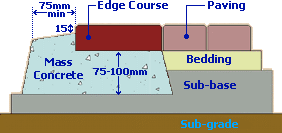Why doesn't it fit?
-
Juicy Lucy
- Posts: 2
- Joined: Wed Jun 30, 2004 4:43 pm
Help, DIY girlie here (nightmare!). What have we done wrong? We followed your instrucitons, excavating 200mm; 100mm type 1; I layed all the soldiers myself on a mortar bed (its only a little patio); sharp sand next, with one pass of the whacker, screeded loveley. Laid out 90 degree herringbone, filled in little edgy bits, swept over kiln dried, then whacked it....loads, all different directions, but in some areas it is still about 10mm - 15mm proud of the soldiers. What have we done wrong?
-
84-1093879891
What depth did you set the screed to? For 50mm blocks, you need a screed depth of 40-44mm. For your blocks to be 10-15mm high suggests the screed depth can only have been 35mm at most, which is nowhere near enough (sas you've found!)
Fear not, fair damsel, for all is not lost. It shouldn't be too difficult to lift the blocks, re-screed to the correct screed depth, and then re-lay the blocks.
Tell me which blocks you're using and I'll give you a guide to screed depth.
Fear not, fair damsel, for all is not lost. It shouldn't be too difficult to lift the blocks, re-screed to the correct screed depth, and then re-lay the blocks.
Tell me which blocks you're using and I'll give you a guide to screed depth.
-
Juicy Lucy
- Posts: 2
- Joined: Wed Jun 30, 2004 4:43 pm
-
77-1093879623
Dunno whether it's the same problem we had in places:
The concrete bedding for the soldiers was high enough to cause the blocks nearest the edge to stay proud of the soldiers - the whacker just couldn't compact them as they were resting on bits of the concrete bed.
A judicious bit of freestyle angle grindering on teh edge of the blocks to provide a gap underneath helped.
Still got some to do, mind.
Tony - any comments?
The concrete bedding for the soldiers was high enough to cause the blocks nearest the edge to stay proud of the soldiers - the whacker just couldn't compact them as they were resting on bits of the concrete bed.
A judicious bit of freestyle angle grindering on teh edge of the blocks to provide a gap underneath helped.
Still got some to do, mind.
Tony - any comments?
-
84-1093879891
One at a time - Lucy first:
Your screeded bed was way too high. Using a 50mm Brett block (not that Brett's are any different to anyone else's!) you should have had a depth to screed of around 43mm. I can't say it should have been exactly 43mm, as there are so many other factors that affect the required screed depth, including overall depth of sand, moisture content, degree of compaction amongst others, that I can only say it should be around 43mm. It might actually be 41mm, or it could be 46mm, but I know it's definitely NOT 25mm, as you had!
The 'tightness' of the blocks when laid is nowt to do with it. The blocks are supposed to be laid 'hand tight' so, in effect, they can't be overtight if laid by hand. If you're having to use amallet or maul to get them to fit, then that's too tight!
And so on to Moosey....
The concrete bedding is supposed to be removed from the inside of the edge course blocks to preclude just this problem. If you look at any of the drawings used on the site, such as this one...

...you can see that the concrete at the inside edge of the block is angled downwards so that there is virtually no concrete beneath the body blocks.
This problem is part of the range of problems referred to as "differential settlement" - the blocks laid on an all-sand bed settle to a different degree than those on a part sand/part concrete bed. That's why it's so important to scrape away any excess concrete from the inside face of the edge courses just after they've been aligned and haunched, while the concrete is still plastic.
Your screeded bed was way too high. Using a 50mm Brett block (not that Brett's are any different to anyone else's!) you should have had a depth to screed of around 43mm. I can't say it should have been exactly 43mm, as there are so many other factors that affect the required screed depth, including overall depth of sand, moisture content, degree of compaction amongst others, that I can only say it should be around 43mm. It might actually be 41mm, or it could be 46mm, but I know it's definitely NOT 25mm, as you had!
The 'tightness' of the blocks when laid is nowt to do with it. The blocks are supposed to be laid 'hand tight' so, in effect, they can't be overtight if laid by hand. If you're having to use amallet or maul to get them to fit, then that's too tight!
And so on to Moosey....
The concrete bedding is supposed to be removed from the inside of the edge course blocks to preclude just this problem. If you look at any of the drawings used on the site, such as this one...

...you can see that the concrete at the inside edge of the block is angled downwards so that there is virtually no concrete beneath the body blocks.
This problem is part of the range of problems referred to as "differential settlement" - the blocks laid on an all-sand bed settle to a different degree than those on a part sand/part concrete bed. That's why it's so important to scrape away any excess concrete from the inside face of the edge courses just after they've been aligned and haunched, while the concrete is still plastic.
-
77-1093879623